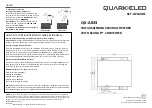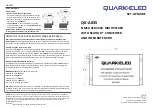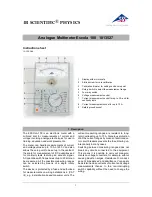
Measuring the capacity
Caution!
Discharge each capacitor before connecting it to the measuring instrument. If
capacitors are short-circuited, high-energy discharges can be caused. Do not
touch the connections of capacitors with voltages above 35VDC or 25VAC. Pro-
ceed with caution. DANGER!
Never carry out measurements at capacitors which are installed into cir-
cuits/circuit components.
Proceed as follows to measure unipolar (electrolytic capacitors) and bipolar capacitors:
a) The measurement set-up (connection of the measuring lines) corresponds to the
one used for the resistance measurement. For the VC-820, set the rotary switch to
position „
“.
b) Now connect the measuring prods to the capacitor. Observe the „+“ and „-“
(polarity) when measuring electrolytic capacitors. Ensure that the connections are
sufficiently long and clean.
Notes!
If the capacity is measured, residual capacities of up to 1.5nF can be indicated
even if no capacitor is connected. Therefore, it is recommended to set the indi-
cation to zero by pressing the „REL“ button before starting the measurement.
The following subfunctions can be set:
Holding the measuring value „HOLD H“ and reference measurement „REL“.
Measuring frequencies
Proceed as follows to measure the frequency of sinusoidal alternating voltages up to
max. 10MHz:
a) Connect the measuring lines to the measuring instrument turned off; ensure the
correct polarity. The red measuring line is to be connected to the Hz/V/ohm input
and the black measuring line to the „COM“ (= ground or „-“). Make sure they are
plugged properly.
b) Move the rotary switch to “Hz” and turn on the measuring instrument. After a short
initialisation phase (all segments are visible), the measuring instrument automati-
cally switches to the lowest possible range of measurement. A manual range
selection is not possible when measuring frequencies.
c) Connect the measuring prods to the object to be measured.
d) If you like to activate the informative pulse-pause ratio indication for TTL levels in
% instead of the normal frequency indication in „Hz“ (kHz, MHz), you have to
press the „Hz %“ button once. Now, the indication theoretically ranges up to
99.9% with a maximum resolution of 0.1%. You return to the frequency measure-
ment by pressing the „Hz %“ button once more.
29
















































